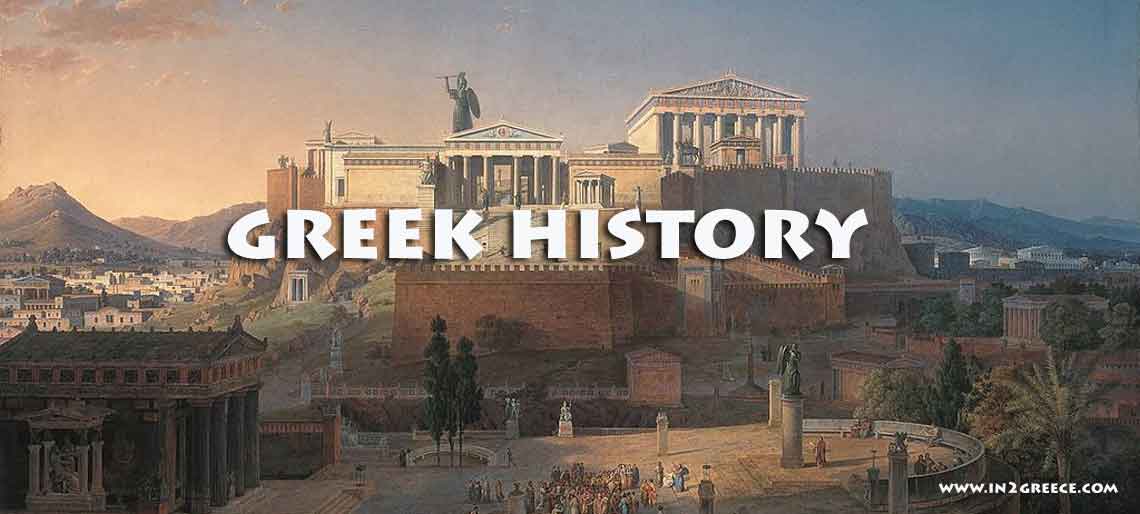History of Byzantine Greece
Constantine the Roman Emperor from 324 to 337 decided to found a new Rome, and in 324 AD he moved the capital to the East, to the Greek city Byzantium on the Bosporus. He named the city Constantinople after himself. The empire was still Rome, though, and the inhabitants called themselves Romans or Romei in Greek.
Constantine inaugurated the fortified city of Constantinople on the site of Byzantium on the Bosporos in 330. Soon called New Rome, the city became capital of the Roman world after the fall of ‘old Rome’ in 476.
The modern name for this empire is ‘Byzantine’, after the city it superseded, but it described itself, in Greek, as Empire of the Romans or Romania . After the reforms of Constantine, the Greek East gradually evolved into a separate political and cultural entity with Greek as its main language and Latin an official entirely replaced Latin as the language of law and administration.
The Byzantine, or East Roman, Empire covered today’s Balkan Peninsula, plus western Turkey, Syria, Jordan, Israel, Lebanon, Cyprus, Egypt and east Libya. Most people spoke Greek, but other languages such as Latin, Armenian and Coptic were also spoken.
There was a close relationship between the emperor and the church, and it was during the Byzantine period that many standards were set for the Orthodox Church. Most land was owned by the emperor and the church, and the empires major economical factor was agriculture but also trade.
In the 5th and 6th century the Byzantine armies had to fight both the invading Huns and Goths, but managed to secure the Empire.
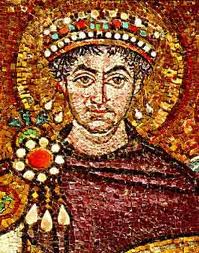
Byzantium suffered invasions from the Germanic Lombards and Turkish Avars, and during the 7th century huge areas of the Balkans had been lost to the Turks and the Slavs.
The Emperor Maurice was assassinated in 602 after twenty years of rule, and this led to both civil war and war with external factors. In 610 Heraclius came to the throne, and he managed to defeat the Persians in 628 after years of wars. Although this was an important victory, returning Syria, Palestine and Egypt to Byzantium, the Empire was seriously weakened. Internally it suffered conflicts between different Christian fractions, and together with the weakened economy after so many wars, the Byzantine empire was to suffer many setbacks from the invading Arabs.
The Arabs were now Muslim, and the new religion had given them inspiration to expand, and they took large parts of the Byzantine empire, including Palestine, Syria, Egypt, Mesopotamia and large parts of Asia Minor.
The Byzantine armies were reorganized in order to control the empires financial doings, with one general per district that would control his area. The infrastructure was losing ground fast, and almost everywhere the commercial market degenerated. Education and agriculture declined, and people left the cities.
Sometime around 730 the iconoclastic dispute started when Leo III forbade the use of icons in worship. This conflict was to go on for a span of a century, and set many rules for art in Orthodox Christianity.
The Byzantine empire was to regain strength from the 9th to the 11th century, getting back areas in Asia Minor as well as in Greece and Macedonia.
Basil I was the founder of the Macedonian dynasty, which was to rule in Byzantium for 214 years. The dynasty strengthened the empire, and gave emphasis to classical Greek aspects of Art and Literature. Unfortunately, the empire’s land was gradually coming into the exclusive hands of a few noble families and the church.
Basil II both expanded the empire and crushed a Bulgarian rebellion, but did not manage to do anything about the way the land was distributed. Byzantium continued to grow economically even after he died, but the internal development was obstructed by the new emperors neglect of new technologies and economical developments that happened around the empire, both in Europe and Turkey, and the Byzantine army was getting weaker.
From the Turkish victory at the Battle of Manzikert on, the Byzantine empire was to lose ground totally. The Turks conquered more and more of the empire, and the West distanced itself because of the Christian schism of 1054 resulting in the western church becoming the Catholic and the Eastern the Orthodox.
The continuous Turkish invasions forced the emperor Alexius I Comnemus to beg the Pope for help, and the First Crusade was set in 1096 against the Turks. This seemed at first to help, but when the Italian merchant cities got special privileges, they slowly took control of the Byzantine commerce.
Even though the empire was coming up a little bit during these times, the benefit mainly came to the Venetians and crusaders.
Constantinople was sacked by the crusaders in 1204 during the Fourth Crusade. A Latin Empire of the East was established, only to fall when the Byzantine emperor Michael VIII Palaeologus seized power in 1261. The Palaeologan house was to rule for almost 200 years, but the empire was basically on the verge of total bankruptcy by this time. The Ottoman Turks invaded parts of the empire, and in 1453 they conquered Constantinople, thus ending what we call the Byzantine period.
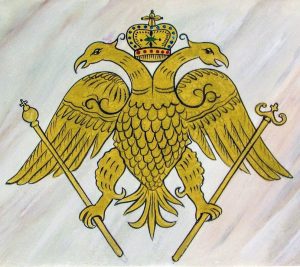
Byzantium we mean the state created in the eastern territories of the Roman Empire, with Constantinople as its capital. It must be understood from the outset that a state with this name has never existed throughout its historical course, but is a creation of modern historians.
The citizens of this state themselves considered themselves Romans and the emperor had the official title “In Christ King of the Romans”. This means that the so-called Byzantines felt the heirs of the Roman Empire and its successors. From this feeling comes the name Romiosini and the surname Romoi, by which the Greeks even today identify themselves. After all, the name of the capital of the state was New Rome, another element that proves the sense of continuity with the old Rome that continued its subjects, regardless of whether the name Constantinople later prevailed, in honor of the founder of the city.
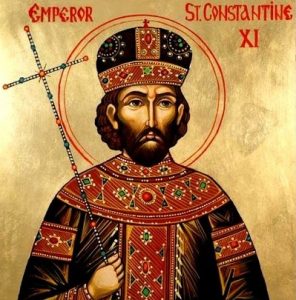
For the past centuries they have accepted that the term Eastern Roman Empire can be used, because this state still retains several Roman features, with the use of Latin first of all. Another fact that we must keep in mind is that the term Greek, at least until the Palaeologian period, has no national significance, nor does it characterise any race or people. For the Byzantines it means the pagans, the pagans, while in the last centuries of the historical course of the empire it has an educational content, in the sense that it defines a certain kind of education. Greece is a limited geographical region, about as far as present-day Thessaly, a not so important region within the borders of the empire.

This is proved by the fact that many people from the peoples who were considered barbarians by the Byzantines ascended the imperial throne. The only condition imposed on a barbarian to get a career in the state machine was to be baptised a Christian and to swear allegiance to the emperor. Racism in the current sense of the term was probably unknown to the Byzantines. The Byzantines may have considered those living outside the empire barbarians, but they never closed their doors to their ambassadors, nor did they refuse to culturally assist them and make them part of their culture.
Even their settlement within the empire, under a regime of autonomy, a practice that began during the reign of Theodosius the Great, to reduce the pressures exerted by these peoples and which later became a constant of Byzantine diplomacy, was accepted under certain conditions. . It is a well-known cultural radiance and influence that Byzantium exerted on many peoples, as well as its heritage that still exists today, especially in the Orthodox world. Byzantium is a purely multinational society, homogenised by religion and the Greek language and not by racial origin.

But these views are the thoughts and theories of later historians, who see the state of the East as a new entity and not as a continuation of the old Roman. Since the Byzantines themselves consider themselves to be the successors of the old empire and since this state grew mainly in the eastern provinces of ancient Rome, it is correct to define the founding of Constantinople, the capital of this state, as beginning of the Eastern Roman Empire.
Things are simpler with regard to the end of the empire. It was placed almost unanimously in 1453, when the city was occupied by the Turks. Some, mainly Greek scholars, place in 1204, the year of the conquest of Constantinople by the Latins, the end of the empire, based mainly on the fact that the Greek language is now almost formed and is very similar to today’s language. However, this does not seem right, because the political and institutional organisation of the state, after its recovery in 1261 by the Palaeologians, continues to be based on the same bases as in previous periods.
Regarding the division of Byzantium’s history, we can distinguish three periods with their respective subdivisions
1) The Early Byzantine period: It lasts from 330 to 610 and is divided into 2 sub periods, the one that lasts from 330 to 518, during which the state is established and the period of the reign of Justinian and his successors, from 518 to 610, when the state reaches its maximum prosperity, from a territorial point of view.
2) The Middle Byzantine Period, which lasts from 610 to 1204. It is divided into four periods: The first from 610 to 717 has as its main feature the Hellenisation of the state, with the imposition of the Greek language as dominant in its position Latin. The second, from 717 to 867 is the period of iconoclasm. The third, from 867 to 1025 is the time of the military and cultural renaissance of Byzantium, with the Macedonian dynasty. The fourth and last, from 1025 to 1204, despite the relative prosperity of the Komnenian era, is characterised by the rapid decline of the state and the conquest of the city by the Crusaders.
3) The Late Byzantine period, which lasts from 1204 to 1453, is divided into two periods. The first from 1204 to 1261, when Constantinople was in the hands of the Latins and various Greek states were founded in the territory of the empire and the second, the Palaeologian period, which ends in 1453 with the fall of Constantinople to the Ottomans.
The Arts in Byzantium
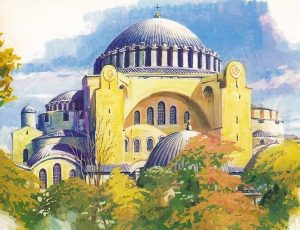
Byzantine superiority brought about the emulation, appropriation and rivalry of neighbouring societies. The Byzantine tradition was copied in Moscow, suiting its claim to be the Third Rome after 1453. The emerging kingdoms in the Balkans copied Byzantine art and ceremonial.
The eastern Orthodox churches showed their kinship with Byzantium by accepting its pictorial conventions, while the non-Orthodox churches of the East were profoundly influenced by Byzantium, but developed their own identity by subtle changes of style and subjects. One of the most successful artists from Armenia was Toros Roslin, who combined pictorial elements from Byzantium, Armenia and the West into his own original national style .
Byzantium and Islam came to admire the qualities of each other’s art, leading to a cross-fertilisation between two different faiths. The period of Constantine VII Porphyrogennetos (913-59) is notable for its classicising art, its encyclopaedic books and the collection and re-copying of the famous Greek books of antiquity. Some of the crowns, the gilded glass bowl and the enamel icons once kept in the Great Palace are now in the Treasury of San Marco at Venice. The Great Palace at Constantinople was accessible mostly to the elite. In 949 the Western ambassador Liudprand of Cremona was granted an audience with Constantine Porphyrogennetos at court: ‘Before the emperor’s throne stood a tree, made of gilded bronze, its branches filled with birds also gold, uttering different cries,depending on their species. The throne was so marvellously fashioned that at one moment it seemed a low structure, and at another it rose high into the air. It was immense and guarded by lions made of bronze or of wood covered over with gold who beat the ground with their tails and gave a dreadful roar with open mouths and quivering tongue … I three times made obeisance to the emperor with my face upon the ground.’
The luxury of the court is revealed in its treasures, sometimes deeply spiritual in their subjects, like the ivory triptychs, sometimes subversive in their parodies of pagan images, like the Veroli casket, and sometimes imperious in their expression of power, like the Troyes casket.
